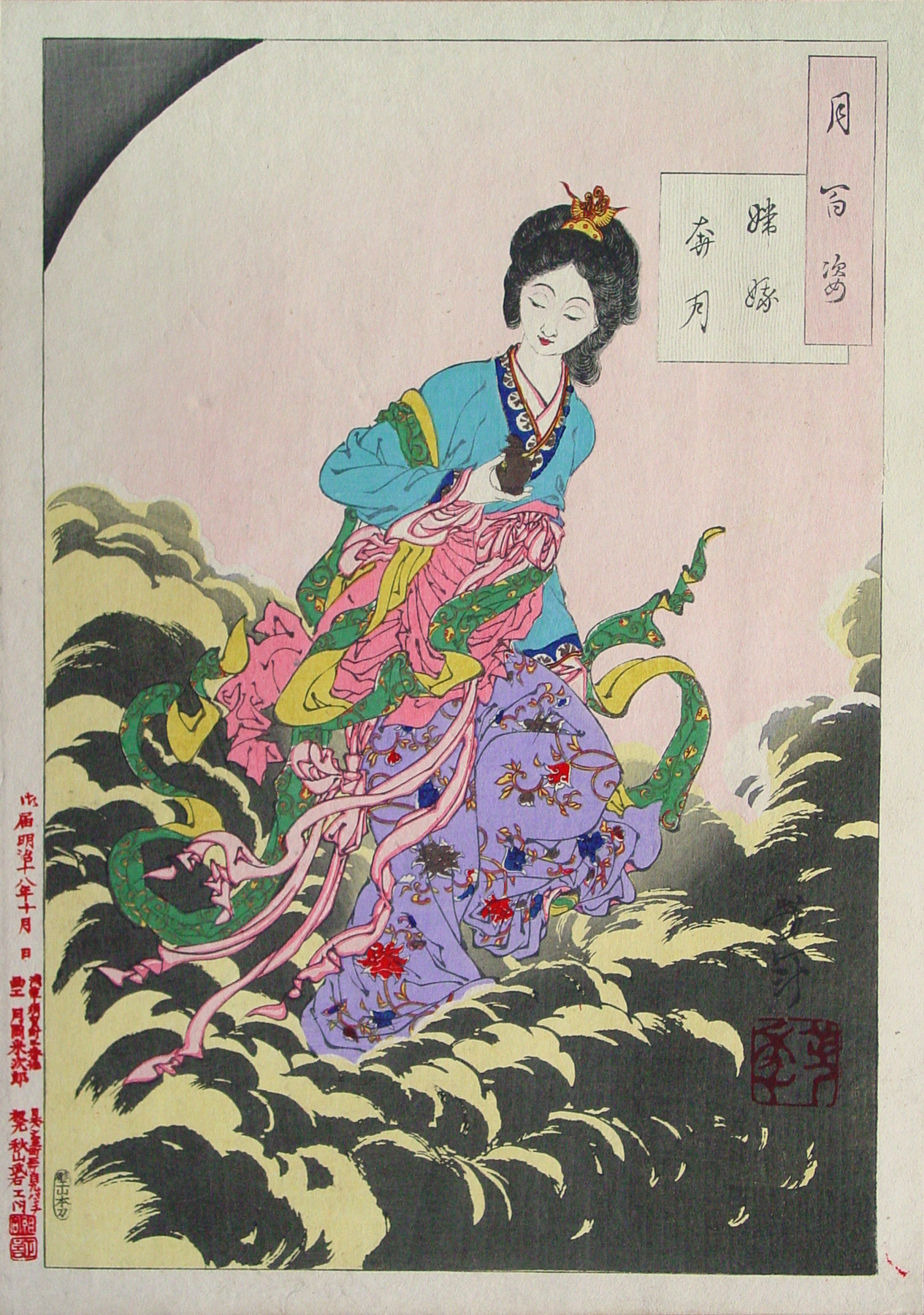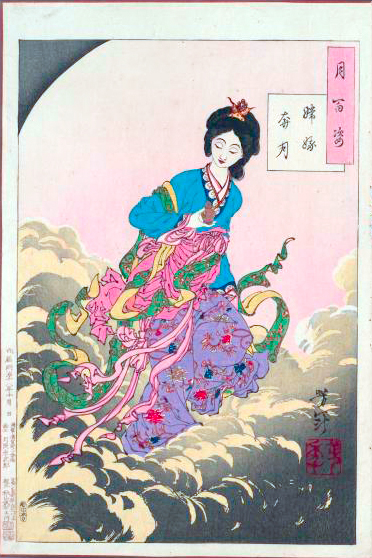About This Print
Source: Museum of International Folk Art http://www.internationalfolkart.org/exhibitions/past/moonweb/section1/019.htm
According to Chinese legend, the Queen Mother of the West rewarded Chang E's husband with a vial of the elixir of immortality. Chang E stole the elixir, drank it, and fled to heaven where she became the spirit of the moon.
This print is from the album issued by publisher Akiyama Buemon shortly after Yoshitoshi's death and retains its original album backing.
Source: Yoshitoshi's One Hundred Aspects of the Moon, John Stevenson, published by Hotei Publishing, Netherlands 2001
2.
2.
Chang E flees to the moon.
Jōga hongetsu tsuki
An ancient Chinese story explains how the moon came to have a queen. The lady in this print, Chang E, called Jōga in Japanese, was the wife of an archer, Hou Yi, who served the mythical Yao, emperor of China, four thousand years ago. One night the moon became “a prisoner of the clouds” (i.e. was eclipsed), and it seemed that the world was about to end. When Emperor Yao ordered Hou Yi to rescue the moon, the archer shot arrows into the sky, and the moon reappeared. As his reward for saving the world, the ruler of the land of the Immortals, a Daoist deity called Xi Wang Mu, “Royal Mother of the West,” gave Hou Yi a jade cup containing the elixir of life. Before he could drink it, his wife stole the cup, drank the elixir herself, and then fled to the moon, where she reigns as goddess.
The story is sometimes taken further. By drinking the elixir, Chang E became immortal, and the gods were therefore unable to punish her presumption with death. Instead they changed her into a frog. The frog represents rain and is associated with the hazy moon that indicates the coming of rain. The frog who lives in the moon sometimes tries to swallow it, another early attempt to explain eclipses. Attempting to swallow the moon became a Daoist metaphor for the unattainable.
Chang E is wearing Yoshitoshi’s conception of archaic Chinese robes – ribbons flutter as she floats over a sea of clouds. The clouds are printed in yellow, black and gray, with the white edges of the clouds left unprinted. The printing process flattens the fibers of the paper, leaving unprinted areas standing in relief with the natural, rough texture of the paper. The pink of the moon behind Chang E is a very fugitive color, which will lose its freshness in a matter of days if exposed to sunlight.
Chang E’s face is foreshortened as she looks down at the jade container, which has a frog on its cover. Rather than use the traditional conventions of woodblock prints, Yoshitoshi often showed his figures from unusual angles. This enabled him to give a larger range of expressions to his characters, increasing his ability to convey mood.
A fascinating discovery has recently been made in China. Wall paintings that illustrate a procession of the Royal Mother of the West have been found in a tomb in Henan which dates from 49 B.C., when Chang E’s story was already ancient. Included in the procession are symbols associated with the deity, all of which are represented in the Moon Series; a white moon (representing the yin, or female, essence), a frog (the metamorphosis of Chang E), a rabbit, a nine-tailed fox, and a sacred cassia tree. The roots of Chinese and Japanese mythology run very deep.
And, A Different Story Behind the Print
Source: Minneapolis Institute of the Arts http://minnesota.institute.art.museum/viewer/detail.php?id=62539&i=870&v=2&dept[]=13&dept[]=1&cc=Japan
According to Chinese legend, the archer Hou Yi shot down nine of the ten suns whose combined heat threatened to destroy the earth. As a reward, the Queen Mother of the West gave Hou Yi an elixir of immortality. Hou Yi's wife, Chang-E, unwittingly drank the potion herself. Rising to the moon, she has lived there ever since within the crystal walls of her "Cold Palace."
During the eighth lunar cycle each year, when the Chinese believe that the moon is at its fullest, they make offerings to Chang-E in the form of small round cakes and sphere-shaped fruit. Although the story of Chang-E is not popular in Japan, Yoshitoshi drew upon the Chinese legend for this design.
According to Chinese legend, the archer Hou Yi shot down nine of the ten suns whose combined heat threatened to destroy the earth. As a reward, the Queen Mother of the West gave Hou Yi an elixir of immortality. Hou Yi's wife, Chang-E, unwittingly drank the potion herself. Rising to the moon, she has lived there ever since within the crystal walls of her "Cold Palace."
During the eighth lunar cycle each year, when the Chinese believe that the moon is at its fullest, they make offerings to Chang-E in the form of small round cakes and sphere-shaped fruit. Although the story of Chang-E is not popular in Japan, Yoshitoshi drew upon the Chinese legend for this design.
About the Series "One Hundred Aspects of the Moon"For details about this series which consists of one hundred prints with the moon as a unifying motif, see the article on this site Yoshitoshi, One Hundred Aspects of the Moon.
Print Details
| IHL Catalog | #58 |
| Title | Change E Flees to the Moon (Jōga hongetsu tsuki 嫦娥奔月) |
| Series | One Hundred Aspects of the Moon (Tsuki hyaku sugata 月百姿) |
| John Stevens Reference No.* | 2 |
| Artist | Tsukioka Yoshitoshi (1839-1892) |
| Signature | Yoshitoshi 芳年 |
| Seal | Yoshitoshi 芳年 |
| Date | October 1885 (御届明治十八年十月 日) |
| Edition | Likely from the album issued by publisher Akiyama Buemon shortly after Yoshitoshi's death |
| Publisher | Akiyama Buemon (秋山武右エ門) [Marks: seal 26-132; pub. ref. 005] |
| Carver | Chōkō Yamamoto tō 彫工山本刀 [full name Yamamoto Shinji] |
| Impression | very good |
| Colors | excellent |
| Condition | excellent - Japanese album backing paper; very minor marks and flaws |
| Genre | ukiyo-e |
| Miscellaneous | |
| Format | oban |
| H x W Paper | 13 3/4 x 9 3/4 in. (34.9 x 24.8 cm) |
| H x W Image | 12 7/8 x 8 3/4 in. (32.7 x 22.2 cm) |
| Collections This Print | Smithsonian National Museum of Asian Art S2003.8.3019; ArtGallery of Greater Victoria 1997.046.001; The British Museum1906,1220,0.1412; New York Public Library Humanities and SocialSciences Library / Spencer Collection; Minneapolis Institute of theArts 2002.161.1; Yale University Art Gallery 2011.143.1.2; Hagi Uragami Museum (Yamaguchi, Japan) UO1504; Tokyo Metropolitan Library 加4722-82; The Tsubouchi Memorial Theatre Museum of Waseda University 201-4504; Ritsumeikan University NDL-541-00-093 |
| Reference Literature | * Yoshitoshi’s One Hundred Aspects of the Moon, John Stevenson, Hotei Publishing, Netherlands 2001, pl. 2. |




